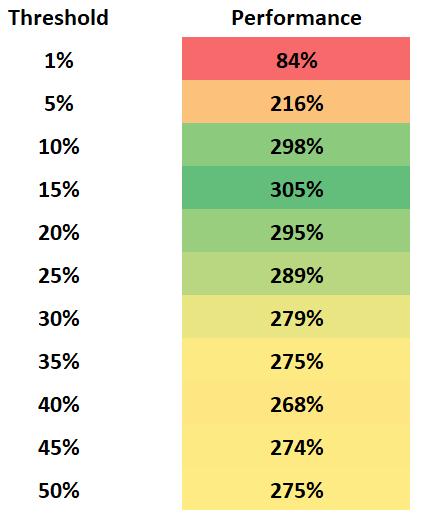Portfolio rebalancing is a strategy that investors use to realign the weightings of the assets within a portfolio. In crypto trading, this strategy allows cryptocurrencies to be restored to their initial state. Crypto portfolio rebalancing ensures a healthy mix of crypto assets and helps traders maintain their desired level of risk.

What Is Portfolio Rebalancing?
Rebalancing a crypto portfolio means redistributing asset allocation to maintain the original or desired allocation or risk. Traders can do this by periodically buying or selling assets in a portfolio.
Example of a Crypto Portfolio
For example, consider a portfolio with 25% each of Bitcoin (BTC), Ethereum (ETH), Chainlink (LINK), and Cardano (ADA). Suppose BTC performs well and its weighting increases to 30%, but ETH underperforms and its weighting drops to 20%. In this scenario, the trader may sell BTC and buy ETH to return their portfolio to the initial allocation.
In a crypto portfolio, each cryptocurrency’s weighting is based on its value in fiat currency (such as USD or EUR). Since the different cryptocurrencies are valued differently, a uniform weighting doesn’t imply a uniform quantity of each cryptocurrency. Thus, a value-based system is a more straightforward way for traders to keep track of the way their assets are allocated.
What are the different ways to rebalance portfolio?
There are two main portfolio rebalancing strategies: periodic rebalancing and threshold rebalancing.
Periodic rebalancing a Portfolio
Periodic rebalancing involves rebalancing a portfolio at a predetermined time interval. This method is the simplest for beginners. A trader can rebalance their portfolio once every hour, day, month, or by any other fixed time interval, depending on their risk tolerance. Due to the crypto market’s volatility, a shorter time interval may be suitable for crypto traders seeking to maximize their returns while minimizing risks.
Threshold rebalancing a Portfolio
Threshold rebalancing refers to rebalancing a portfolio when an asset’s weighting exceeds a particular value. Returning to the previous four-asset portfolio example, imagine the trader sets their preferred target threshold at ±5%. If BTC’s initial 25% weighting rises to 30% or drops to 20%, it’s time to rebalance the portfolio.
A Combined Portfolio Rebalancing Strategy
Traders can combine the two strategies to balance risk management and cost savings. In a combined strategy, a trader would review their portfolio’s asset allocation based on a schedule, and rebalance their portfolio if the asset allocation has reached the rebalancing threshold.
Example of a Rebalancing Strategy
For example, suppose a trader uses a weekly rebalancing strategy, reviewing their portfolio every Saturday, and also sets a threshold of 10%. When Saturday arrives, the investor will review the asset allocation. If the asset’s allocation drifted by only 5%, the investor would not rebalance their portfolio. Similarly, if the allocation drifts by 10% during any intermediate day, the investor will not rebalance their portfolio. In short, the trader only rebalances their portfolio when the threshold requirement is met during the rebalancing date.
For convenience, some experienced investors use automatic rebalancing tools. Some are free, and some require a payment or subscription. In addition, different tools are compatible with different cryptocurrency exchanges, so it’s important to check a tool’s supported exchanges before paying.
What Is the Best Rebalancing Strategy?
To evaluate periodic rebalancing, a study examined the influence time intervals have on a portfolio’s performance. The study compared the HODL strategy to hourly, daily, weekly, and monthly rebalancing strategies for cryptocurrency portfolios of two, four, six, eight, and ten assets.
How Often Should You Rebalance Your Portfolio?

Influence of the rebalancing period on the performance of portfolios of different sizes. The percentages represent the performance increase over buy-and-hold strategies. (Source: Shrimpy.io)
A second study analyzed the impact of different thresholds on a portfolio’s performance. The study used thresholds ranging from 1% to 50% to identify a trend. Similar to the previous study, the study compared portfolios using threshold rebalancing strategies to a portfolio using the HODL strategy. As shown in the figure below, the 15% threshold-based rebalancing strategy yielded the highest performance.

Influence of rebalancing thresholds on a portfolio’s performance. The percentages represent the performance increase over buy-and-hold strategies. (Source: Shrimpy.io)
The second study also found that the 15% threshold-based rebalancing strategy performed better than periodic rebalancing strategies.
Take note that these studies used the exact bid-ask data and transaction fees from specific cryptocurrency exchanges. Traders using aggregated data from TradingView or CoinMarketCap may end up with wildly inaccurate calculations. Also, cryptocurrency exchanges have different fees and asset prices, which can affect the portfolio’s performance.

Why Rebalance a Crypto Portfolio?
The primary purpose of rebalancing a portfolio is to manage risk. Asset allocation is an essential component in ensuring stable returns. It’s common for investors to continue holding an investment when the asset’s price is in an uptrend. However, cryptocurrency markets are incredibly volatile. A long-term overallocation to one asset may result in huge losses when the asset’s price reverses. When rebalancing a portfolio, a trader profits from the overperforming asset and reinvests it into other assets. By doing this, traders can maintain their risk profile regardless of market movement and reap the benefits.
Crypto portfolio rebalancing also offers investors an opportunity to increase the profitability of their investments. By selling an asset that has overperformed and buying an underperforming asset, investors fully utilize the buy low and sell high strategy. As the market reverts to the mean, overall returns increase.
Portfolio rebalancing can also help investors stay grounded. By adhering closely to a portfolio rebalancing strategy, investors are less likely to make emotion-driven decisions when an asset crashes or experience FOMO when an asset rises in price. With predetermined rules, investors can maintain focus on their investment plan.
What Are the Possible Drawbacks of portfolio rebalancing?
Crypto portfolio rebalancing does involve some potential drawbacks and risks:
- An investor may cut short an asset’s bullish trend by selling too early, and then buy another asset that drops in price soon after. This creates a “sell low, buy high” scenario, resulting in losses.
- Portfolio rebalancing only works when the assets in a portfolio are generating value. For example, imagine a trader has a portfolio with 50% BTC and 50% some other token. After some time, when the trader reviews his portfolio, BTC’s price is trending upwards while the other token is trending downwards or sideways. Based on the principles of portfolio rebalancing, the trader should sell BTC and buy the other token. But that would mean selling BTC for a token trending downward. Thus, before incorporating a portfolio rebalancing strategy, traders should do their own research and assess the value of their investments.
- Tax requirements can make rebalancing a hassle. Depending on the country or region, an investor might be required to pay capital gains taxes on transactions when selling an asset to rebalance a portfolio. For example, the US Internal Revenue Service (IRS) recently classified cryptocurrencies as assets similar to property.
- Due to the cryptocurrency market’s volatility, investors may need frequent rebalancing, which can be costly and time-consuming. High-volume traders may not be able to do this by hand and might need to utilize cryptocurrency tax software.
- Traders have to pay transaction fees to the cryptocurrency exchanges during portfolio rebalancing when they sell and buy assets. For novice traders with cryptocurrency portfolios of lesser value, portfolio rebalancing might cancel out their gains after accounting for the transaction fees.

How to Rebalance a Crypto Portfolio?
Crypto portfolio rebalancing requires only three simple steps:
- Record the initial asset allocation: Once you’ve decided on a rebalancing strategy and purchased the crypto assets of your choice, record the total money spent and the value of your portfolio. These records will serve as historical data for future comparisons.
- Review and determine the current allocation: On the rebalancing date, review your portfolio and determine the weightings of each asset. Then, compare the current weightings to the initial or desired asset allocation. If the allocation has drifted significantly, rebalance your portfolio by buying and selling the appropriate assets.
- Reevaluate the risk tolerance: You may want to change your asset allocation based on market or life situation changes that affect your risk tolerance. If you believe the market is moving towards a bullish trend, you might shift to a more aggressive asset allocation to try to maximize gains. Younger traders, who can generally handle higher risks, may choose to invest in less-established cryptocurrencies in hopes of dramatic gains. As you get older, you may choose to be more conservative to maintain stable returns.
Conclusion
Crypto portfolio rebalancing is a useful tool that traders use to manage trading risks. A disciplined investor can maintain their gains by selling overperforming assets and buying underperforming assets. Depending on their expectations, traders can follow the periodic or threshold-based rebalancing strategies, or combine the two to balance risk management and cost savings. Even though portfolio rebalancing involves various risks, most portfolios with a rebalancing strategy will outperform the portfolios using the HODL strategy.
Read More
- Crypto Portfolio Allocation: Should Crypto be Part of Your Portfolio?
- Crypto Trading vs. Investing: Key Differences Explained
- Hedging Bitcoin: 5 Risk Management Strategies in Crypto Trading
- How to Use Risk Parity in Crypto Trading
- What Is Risk Reversal: How to Leverage Trade Crypto Safely
- How To Trade Crypto: The Ultimate Investing Guide
- Buy Low, Sell High Crypto: 4 Things To Do (3 To Avoid)
- Blockchain Analytics: 11 Free Crypto Research Tools You Need









